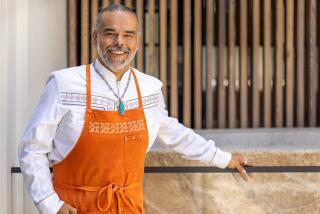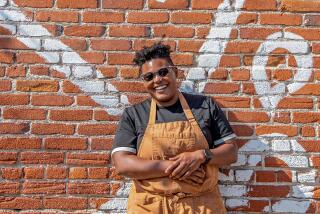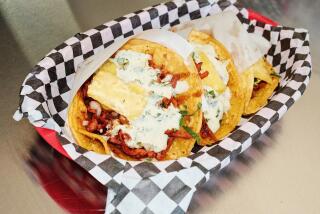THE MAKIN OF TEXAS CUISINE
- Share via
HOUSTON — I feel pretty safe in saying that there is no such thing as Texas cuisine. On the other hand, there is a whole lot more going on gastronomically in our second-biggest state than chili contests and crowds of good ol’ boys standing around watching whole cows revolve on spits.
There are plenty of good chefs in Texas today, and there are plenty of good local products for them to work with. And while there may not be anything describable as Texas cuisine, there are the beginnings of a true regional style in the state, I think--distinct from the “Southwestern” idiom that has lately grown so popular around the country, though using many of the same ingredients.
The best-known chefs in Texas today are Stephan Pyles of the Routh Street Cafe and Dean Fearing of the Mansion at Turtle Creek, both in Dallas, and transplanted Californian Robert del Grande of Cafe Annie in Houston. Other promising local culinary talents include Amy Ferguson at Baby Routh (Pyles’ second restaurant), Lori Finkelman at the Riviera, and Steven Singer at Beau Nash in the Crescent Court Hotel, all in Dallas. And then there’s John W. Makin, who cooks at a hostelry called the Remington on Post Oak Park, in Houston, and who might very well turn out to be the best and most original chef of them all.
Makin is a big, round-faced, pleasant-looking young man who talks with a half-mumbled Texas twang and looks like he could fix your pickup truck between courses if he had to. It is something of a surprise, then, to learn that he is not from these parts at all--that, as he says in that twang, “Ah’m a Eurasian.” He was born in the Philippines; his father was American and his mother Filipina and German. He grew up in Bagiou City, north of Manila in the mountains, where his mother’s family owned a hotel--and he started helping in the kitchen there as soon as he was able. When his family moved to Seattle, he was still too young to work in restaurants here--but as soon as he got his working papers at the age of 14 he was back in the kitchen, first at fast-food places and later at such distinguished Seattle establishments as Rossellini’s 410 and the Mirabeau. There was never any doubt in his mind that he wanted to be a chef. “Cooking is kind of like drugs,” he adds. “It’s addictive.”
In 1977, Makin and his wife, a pastry chef, went off to the Culinary Institute of America in New York to hone their skills. Since that time, he has held top chef’s jobs in hotels. Then, in 1985, he was hired by the Remington, a member of the small, high-quality, food-conscious Rosewood chain.
Makin’s depth of experience shows: He is a confident chef, unafraid of strong flavors and unlikely combinations of ingredients. His sauces are superb: He creates a light but silky-textured variation on a classic mole , for instance, with zinfandel to thin it and pectin (!) to give it body (this for grilled local rabbit that really tastes like meat ); the black bean and ginger sauce he uses for grilled marinated duck is a real sauce, perfect in consistency, and not the sort of watery bean puree found all too often in Southwestern cooking; the deep-brown glaze that coats his sauteed medallions of axis-deer venison (which is genuine game, having been shot on the hoof) is a deft reduction of dark beer--adding a perfect sharpness to the richness of the meat.
Asian influences are visible in Makin’s cooking, through his use of spices and tropical fruit (a hint of guava in the red-wine sauce for his grilled rack of lamb, for example--enough to feel but not quite enough to taste), and in touches like the shiny dim-sum-style pastry dough in his “ravioli” of ground veal and wild mushrooms in a cascabel-chili/butter sauce.
The Southwest comes to the fore with an abundance of chiles, used subtly but recognizably in various sauces, and in some of his garnishes--stir-fried strips of red and green bell peppers, yellow squash and jicama, say, or sauteed batons of Granny Smith and Delicious apples tossed with minced parsley and bits of jalapeno--a knock-out accompaniment to that grilled lamb.
Other dishes look to the East Coast--a rich Maryland she-crab soup with fresh thyme and good sherry, for instance--while Makin’s use of cedar-planked salmon and salmon smoked with alderwood recalls his days in the Pacific Northwest. One wonderful appetizer might even be called a sort of Mediterranean/Texan antipasto plate--thin slices of very lean, almost nutty-tasting “salami” made from the meat of wild Corsican ram and black buck antelope (which, like that axis deer mentioned earlier, were among the exotic game species imported into Texas earlier in the century by hunt-mad millionaires, and now shot commercially) and slightly thicker slices of Catalan-style duck-breast “ham”--both made by Makin--with a shredded bell pepper and yellow squash salad in fresh thyme vinaigrette, and a heap of superlative Spanish olives.
Food like this gets your palate’s attention real quick--and Makin knows what to do with it once he’s got it.
The Remington, 1919 Briar Oaks Lane, Houston, (713) 840-7600. Dinner for two (food only), $50-$75.
More to Read
Eat your way across L.A.
Get our weekly Tasting Notes newsletter for reviews, news and more.
You may occasionally receive promotional content from the Los Angeles Times.









